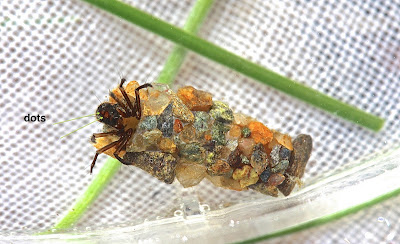Sunday, January 6, 2013
And again, it's Neophylax consimilis: Uenoids at the North Fork of the Moormans
Well, Beaty says it's a mountain species, so there's no reason it should not be the Uenoid species that we find in this Blue Ridge Mt. stream.
I took photos of two different larvae. The one in the photo at the top of the page was the smaller of the two. The one below measured ~ 10 mm while the case it was in was 11 mm.
Those measurements are in full accord with the comments of Thomas Ames. He notes that Neophylax cases can run up to 15 mm in length, "but a mature Neophylax larva is somewhat stout and is only about 1 mm shorter than its home." (Thomas Ames, Caddisflies: A Guide to Eastern Species for Anglers and Other Naturalists [Stackpole Books, 2009, pp. 258-262]). By the way, if you're a fly fisherman, or an amateur entomologist -- or both! -- this is, we'd say in Chinese, a fei you bu-ke de shu 非有不可的書 -- a book that you can't do without: a must have!
Here is a dorsal view of the smaller N. consimilis.
For species ID, you'll recall, we must see 1) clavate gills, 2) a pale area or stripe on the head (but smaller than the stripe that we find on N. oligius larvae), and 3) lateral gills at 2p, 3a, and 4a -- the anterior and posterior edges of abdominal segments 2, 3, and 4). On the larger larva, there appear to be two pale spots on the head which have essentially merged into a stripe.
On the smaller larva, those dots have not yet merged.
Note how this "stripe" differs from that of the Neophylax oligius larva in the photo below.
For the clavate gills, we need to see the larva out of its case.
And for the lateral gills, we clearly need a microscope photo. In this photo, the gills at 2p and 3a show up very well: the one at 4a -- which is smaller and thinner -- is more difficult for us to see.
________________
The Ames book is loaded with information on Uenoids, and on Neophylax, which is the only genus that we find in the East (see pp. 257-262), and he has some wonderful photos of larvae as well as adults. It makes for interesting reading, and let me note some of the things that I've recently learned.
1. The "common" name for Uenoidae is "Little northern casemaker."
2. Adults of the genus Neophylax -- for the fly fishermen reading along -- are called "Little dot-winged sedges."
3. There are 17 species of Neophylax that are found in the East. (Beaty, "The Trichoptera of North Carolina," pp. 86-87 notes/describes 10 species in North Carolina.)
4. Like Beaty, Ames notes that more than one species might inhabit a river/stream. However, he adds, "Although perfectly content to coexist in the same habitat, each species seeks its own ecological niche, so that their populations are sectioned from upstream to down, creating a sort of benthic parfait." (p. 258)
5. Finally -- and this one is news to me -- although Neophylax larvae enter pupation sometime in the spring, only one species will emerge in the spring -- Neophylax ornatus -- the rest do not emerge before late summer or fall. I quote: "As summer approaches Neophylax larvae emulate the stick caddis in seeking cool, safe locations to wait out the season's hottest temperatures. This habit of diapause, beginning in April in some locales and lasting up to six months, is something like a time-out from the normal requirements of life. It allows some species that live in temporary streams to survive periods of reduced flow and even dry spells." ... "Except for the spring emergence of at least one species, the adults begin appearing with the first hints of fall color, and finally disappear when the first leaves fall." (p. 261)
__________________
Neophylax consimilis: tolerance value, 0.3.
________________
What else did I see at the North Fork today? Giant stoneflies, common stoneflies (Acroneuria carolinensis), large winter stoneflies (not sure of ID), Perlodid stoneflies (Isoperla namata), pronggilled mayflies (Paraleptophlebia) , flatheaded mayflies (Epeorus pleuralis), free living caddisfly larvae (R. fuscula), lots of Lepidostomatids, midges, and black fly larvae.
Subscribe to:
Post Comments (Atom)









No comments:
Post a Comment